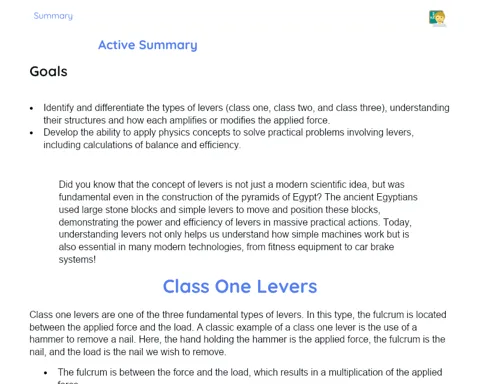Modern Physics: Photoelectric Effect | Active Summary
Objectives
1. 🌟 Understand the phenomenon of the Photoelectric Effect, which challenges classical physics ideas and introduces essential quantum concepts.
2. 🔬 Identify how the interaction between light photons and electrons in specific materials leads to the emission of these electrons, forming the basis for technologies such as solar cells and light sensors.
3. 🛠️ Apply the laws of the Photoelectric Effect to calculate the kinetic energy of emitted electrons and understand the dependence of this energy on the frequency of the incident light.
Contextualization
Did you know that the Photoelectric Effect, explained by Albert Einstein in 1905, was one of the pillars that laid the foundation for quantum theory? This discovery not only challenged the classical laws of physics but also opened the doors to a new era of technologies based on photons and electrons. Today, it is crucial in innovations such as solar cells, where the efficiency of converting solar energy into electricity is directly influenced by the practical application of the laws of the Photoelectric Effect.
Important Topics
Emission of Electrons by Photons
This essential phenomenon, discovered in the early 20th century, establishes that when light photons strike a surface, they can transfer their energy to electrons in the material, and if this energy is sufficient to overcome the work function of the material, electrons are ejected. This is the core of the Photoelectric Effect and is crucial for understanding how light can 'generate' electricity in technologies such as solar cells.
-
It directly depends on the frequency of the incident light: the higher the frequency, the greater the energy of the photon, and thus, the more likely the emission of electrons.
-
The material used is fundamental, as different materials have different work functions, which influences the efficiency of the emission process.
-
This emission of electrons is not instantaneous; there is a slight delay, characterized as response time, which varies from material to material.
Laws of the Photoelectric Effect
The laws formulated by Albert Einstein relate the kinetic energy of emitted electrons to the energy of incident photons and the work function of the material. These laws are expressed in equations that allow precise calculation of the kinetic energy of electrons and understanding how it varies with the frequency of the incident light.
-
The kinetic energy (KE) of the electrons is given by KE = E(photon) - Φ, where Φ is the work function.
-
This relationship explains why below a certain frequency (dependent on the material) no emission of electrons occurs, regardless of the light intensity.
-
It enables the development of technologies that require precision in photon manipulation, such as lasers and imaging devices.
Technological Applications
The Photoelectric Effect is not just a theoretical phenomenon but the basis for countless technological applications. From light sensors in digital cameras to solar cells and security devices, understanding this effect enables the design and optimization of devices that depend on converting light into electricity or making precise light measurements.
-
Solar cells: Transform sunlight into electricity, essential for renewable energy.
-
Light sensors: Used in many electronic devices to automatically adjust screen brightness or to activate in response to light.
-
Lasers: Operate based on the stimulated emission of photons, a concept directly related to the Photoelectric Effect.
Key Terms
-
Photoelectric Effect: A phenomenon in which electrons are ejected from a material when light photons strike it, essential for understanding light-matter interaction.
-
Photon: The smallest unit of light energy, carrying the minimum amount of energy needed to eject an electron from a material.
-
Work Function: The minimum energy required to remove an electron from a material, a crucial parameter in the study of the Photoelectric Effect.
To Reflect
-
How can the understanding of the Photoelectric Effect influence the development of more energy-efficient technologies?
-
Why is it important to consider both the intensity and frequency of the incident light when designing devices based on the Photoelectric Effect?
-
In what way does the study of the Photoelectric Effect challenge our understanding of classical physics laws and pave the way for quantum physics?
Important Conclusions
-
The Photoelectric Effect, discovered by Albert Einstein, is one of the pillars of quantum physics and is essential for understanding how light interacts with matter, influencing technologies such as solar cells and light sensors.
-
The laws of the Photoelectric Effect, which relate the kinetic energy of electrons to the energy of incident photons and the work function of the material, enable the development of more efficient and precise technologies.
-
Understanding this phenomenon not only challenges the classical laws of physics but also opens doors to innovations that directly impact our daily lives, such as in generating clean energy and advanced electronic devices.
To Exercise Knowledge
Conduct a simple experiment at home: using a different colored LED, a battery, and a metal plate, try to observe if different colors of light result in the emission of electrons from the metal. Document your results and discuss your findings with your family or online classmates.
Challenge
Solar Cell Engineer Challenge: Design and build a small solar cell model using recyclable materials at home. Test your model under different lighting conditions and see if you can maximize the energy your solar cell can generate!
Study Tips
-
Watch documentaries or educational videos about the Photoelectric Effect and its technological applications to visualize how theoretical knowledge translates into real technologies.
-
Participate in online forums or study groups to discuss the Photoelectric Effect and its implications with other students and physics enthusiasts.
-
Try to explain to a friend or family member how the Photoelectric Effect works and its practical applications. Teaching is a great way to learn and reinforce your own understanding of the subject.



